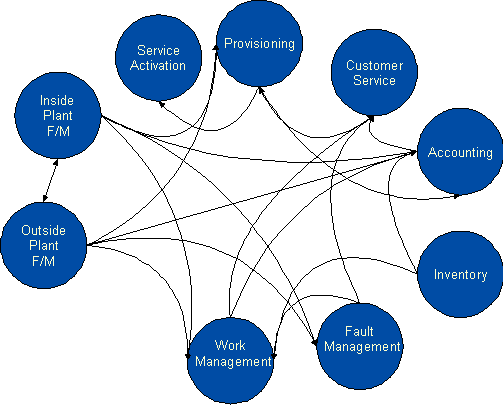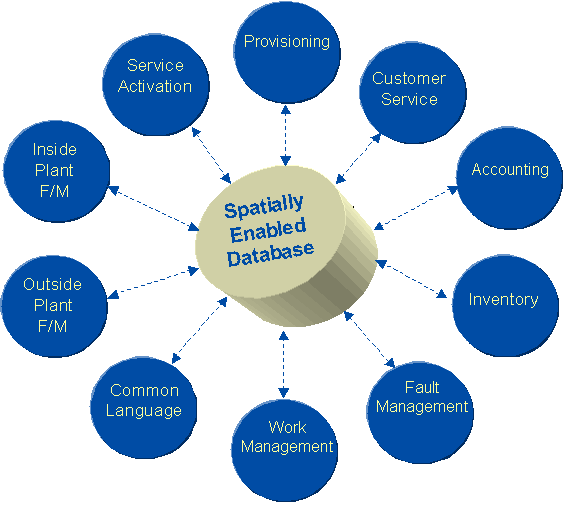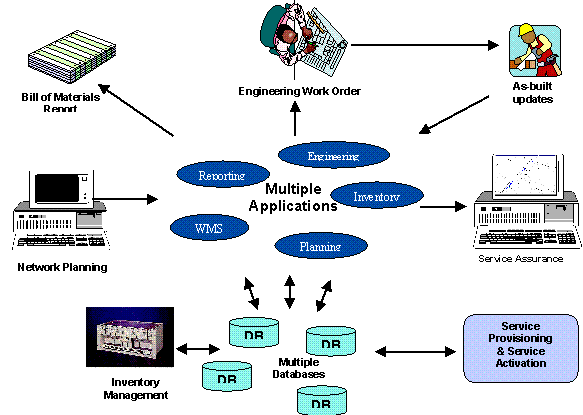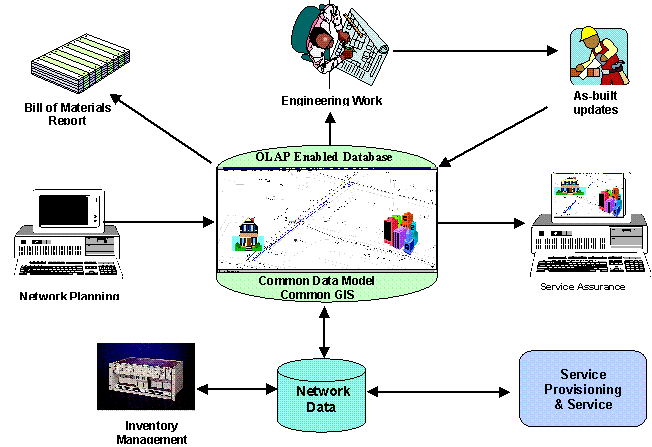
The rapidly expanding telecommunications market is putting greater demand on planning, forecasting, construction, assignment, and maintenance of communications circuits than ever before. Historically, in the world of the Telecom Enterprise each of these processes has been poorly inter-linked and suffered from redundant, or missing data stores. Each of these processes intimately affects the other yet typically each exists in its own island of processes and information. Telcordia Technologies, MESA Solutions, Oracle, and Esri have combined to provide a data-centric solution that originates from a Network Engineering Database to solve this dilemma. This solution provides multiple views into a single data warehouse to share information, to automate circuit assignment, to expedite repairs and to streamline daily business processes.
The expanding telecommunications market is the source of greater demands on planning, forecasting, construction, assignment, and maintenance of communications circuits than ever before. With the signing of the Clinton Telecommunications Act of 1996 in the United States, all barriers between local and long distance providers, cable TV, and wireless communications disintegrated. The industry has entered its most expansive and competitive point in history. The same is happening all across the UK and Europe with deregulation mandated from state and local governments. Developing nations are equally moving away from state-owned monopolies to competitive carriers and providers. These activities result in opportunities for the service provider, for provider support industries, and for the telecom customer in particular.
As competition intensifies and networks become a commodity, service providers are faced with the need to reduce costs, to add value to services, and to ensure differentiation. Once a customer can choose among different carriers, customer care and marketing intelligence become strategic functions in customer loyalty and in gaining and increasing market share. The foundation to success in this arena is the supporting infrastructure of the carrier. The carrier must be flexible and responsive to the customer's needs not just today but also in predicting tomorrow. Decisions must be made on data from multiple sources and information must be provided to all effected organizations in a timely manner.
The challenge is to build the correct platform enabling the carrier to utilize information to provide cost-effective, value-added solutions to the customer. The solution lies in a data-centric approach to the telecom enterprise; this is also known as data warehousing. To further extend the solution, the added dimension of a spatially enabled data warehouse increases the capability of the stored data even further.
For the new entrants, it is actually a much easier solution from the beginning to design the Operational Support System (OSS) with the data warehouse ideology. However, for most incumbent Telecom companies it is a much greater challenge. The good news is that most already maintain abundant and meaningful data in islands of information. This data ranges from effective planning/demographic data, construction information, customer information, network asset and inventory information, to maintenance information. The bad news is that layers of process and proprietary systems often protect each island of information.
Often, Telecom companies operate ineffectively with the information they can siphon from each island of data. The data is often incomplete slices of the “big picture. In other words, the data is meaningless unless converted to information. The ability of the provider to integrate its infrastructure and application tools into the data warehouse determines how well it utilizes information to acquire, manage and retain customers. Currently, a major issue within telecom companies is the inability of IT departments to maintain the latest technology via cost or implementation cycle constraints. Storing data in a central repository eliminates the constraint in the iterative technology cycle of software solutions.
Modern spatial data warehousing should support the organization at a minimum in the following areas.
The current view of data management in many of today's telecommunication companies is a major achievement of organized chaos. There are huge data redundancies, delayed or improper decisions made due to improper network information, and a equivalent amount of data vacuums. Unfortunately, the enormity of the data involved in each process often lends itself to appear an insurmountable task to resolve; hence, due to the apparent risk of mismanaging the data, nothing is done. Figure 1 identifies a sample of some of the inter-process communication that is currently, or at least should be, utilized to keep the enterprise informed of the business process. Unfortunately, many of these communication channels are batch processes or don't exist at all. When that happens, data is either old when used, late when received, or not utilized whatsoever.

There are two ways to solve the data problem. The business can construct the inter-process tools to ensure each island it up-to-date on the activity of each other island or a common data warehouse can be built to store all the pertinent information. The issue with the inter-process communication model is that in the event any one island goes down, all other islands down-wind become isolated and cannot reliably function. Furthermore, to upgrade any one island requires consideration of all inter-process links to make sure fixing one process doesn't break another.
By establishing a common data-model to support the enterprise, the service provider absolves itself from the above mentioned limiting factors and also enables the provider to stay on top of technology without fear of breaking the whole system when the upgrade takes place. Figure 2 identifies the simplification of the data warehousing approach that makes itself blatantly obvious when visually rendered.

To convert an existing process to the common data solution is no easy undertaking. If legacy systems are already in place, a significant effort will be required to migrate the data to this system. To make this transformation there must be good reason to go to the effort. The reason is efficiency, which equates to money retained on the bottom line.
Unlike many other businesses that store their assets in a single building or warehouse, the assets of the utility service provider are maintained across vast regional areas hopefully with expanding boundaries. Understanding the inventory, with respect to location (geocoding), is tantamount to successfully supporting many of the analysis, planning, and regulatory tools required of the utility service providers.
The service provider must offer much more than dial tone today including voice, data, video, and wireless services. At the same time the provider must make it easy and painless for the customer to join while keeping the service competitive and attractive. The customer wants a single bill, Internet accessibility of records and history, and quick resolution to complaints or outages. When the provider can meet these needs, customer turnover, or churn, will drastically reduce and retention should improve.
The objective of Planning and Marketing Analysis is to maximize the revenue potential of the network asset through the optimum mix of products and services, revenue, and profit. To do that the proper asset must be deployed to maximize its ability to provide service while not overbuilding to leave wasted network capacity. By utilizing proper demographic data, marketing can determine the hot spots to target for new or greater bandwidth. That data, once stored in the data warehouse, can immediately be seen by sales to begin a sales campaign to pre-sell capacity on the network. Engineering and construction would also be able to view what is being planned and sold in preparation for future construction efforts.
Effective work management enables organizations to schedule work requests, dispatch personnel, track equipment and materials and forecast the usage of resources. It improves customer service, increases operational efficiency, reduces operating costs and achieves greater staff productivity. Although this is a common island of operational data, when leveraged against existing GIS facility, landbase, and inventory data, it becomes a very effective management tool.
Network planners require accurate information about the network utilization and the ability to link network information to the associated revenue and profit contribution of network elements. For example, a number of network elements may require upgrading. It is advantageous to prioritize the upgrades based on their potential impact on profit. The ability to analyze bandwidth consumption based on network element criteria makes this possible.
Customers regularly expect the following directly from the Internet.
Many companies are not minimizing their cost base due to poor management systems, making them unable to accurately detail and track their assets. The effect of improper asset management results in improper depreciation factors used and inaccurate inventories of many components. Financial and asset systems should be tied together via unique tracking numbers (CLLI codes), which streamlines asset tracking. Managing fixed assets has a significant impact on cost structure and returns notable annual savings. Once the management tool is in place, Just-in-Time (JIT) inventory management can be utilized to promote even further savings.
Comprehensive maintenance, surveillance, and analysis of network integrity is key to keeping the network operational at peak efficiency. The ability to proactively inform the customer, work force crews, and customer service during a potential service interruption or degradation, only further solidifies the relationship necessary to keep the customer informed and satisfied. It also reduces operations costs and ensures uninterrupted, revenue generating, service to the customer.
Managers require a consistent, enterprise-wide view of business information. This requires a single data source which ensures a single view of the customer across all service areas. A top level view is required, although the ability to 'drill down' into specific information is also necessary. Trend analysis and investigation of anomalies can also show marketing and service performance.
In the past, companies invested in proprietary systems and made significant investments to develop applications to support the business. However, these systems often failed to deliver quality information to the business because in most cases data warehousing efforts utilized rehashed on-line transaction processing (OLTP) techniques resulting in data that was outdated, of poor quality, and not entirely relevant. Transaction-intensive systems are designed for the capture and processing of data and are not designed for the provision of information. Attempts to use transaction-intensive systems for information provision fails to address the following issues: 1) Query Performance; 2) Single-View of the Business; 3) Data Legibility; and 4) Integration.
The diagram in Error! Reference source not found. shows a view of a typical telecommunications company, which has several data repositories utilizing various applications. Often, the applications do not have standard interfaces and have not been integrated. This leads to a number of different views of the customer with no ability to integrate the information. Often the data is not complete and cannot be combined into one data model. From a business standpoint, it is impossible to build an accurate, comprehensive profile of the customer, which often leads to incorrect actions being taken.

A key component of the competitive telco is the data warehouse. Many communications companies have been building data warehouses for years. What they haven't been doing is making them flexible, responsive, business focused. To support the new competitive telco, its data warehousing architecture must:
With the advent of robust, scalable open systems, new applications and software tools have been introduced. Today, decision makers use advanced transactional analysis, also known as advanced online analytical processing (OLAP) - to interrogate the data warehouse. This process is sometimes referred to as Multidimensional online analytical processing (MD-OLAP) or relational online analytical processing (ROLAP). In the world of GIS, these tools are known as Spatial Management and are found in many forms including Spatial Database Engine (SDE*), Spatial Data Option, VISION*, Continuum, and SpatialWare** to name a few. These OLAP tools bring the ability to perform fast, intelligent network analysis (tracing and routing), spatial queries, graphic storage, statistical analysis, and the ability to “drill” from high-level data to successive levels of detail for iterative analysis. OLAP engines can be leveraged to deliver high performance and extended analytics for ad hoc queries and reporting tools, as well as for specialized packaged applications (Internet queries, browsing, CIS), or custom executive information systems. The end goal of the OLAP solutions results in the following bottom-line solution for the telecommunication service provider.

Many communications companies today have developed internal systems to support newly introduced services. However, often these systems are not integrated causing problems for customer service representatives handling a customer's request. The current systems result in the customer being passed around from representative to representative to finally conduct the business for which they called (assuming they haven't hung up). Modern applications allow the various systems to be integrated and allow the same representative one view of the customer whether involved with inbound or outbound calls. Another benefit of this system is that each agent can handle more calls, thereby improving productivity and reducing costs. Also important is the reduction in the cost of training new agents. A well-designed system can prioritize a caller. Customers can be segmented into different groups and targeted for various services and level of 'VIP' treatment. Very good customers can call special numbers or the system could flag a caller as a very important customer by matching their phone number to a list.
Technology has created the opportunity for companies to launch a variety of related communications services. Not only do customers want to obtain all their communications services from one company but they also want to receive a single all-inclusive bill. Customers' lives and businesses have become increasingly complicated, a consolidated bill is likely to ease the problem. Additionally, consolidation of this function provides the communications company with a tactical weapon for cross selling and bundled discounting. The bill in itself becomes a product differentiator.
Few companies today have a single view of the customer. The development of various databases, often conflicting, pose significant problems for sales, marketing and finance departments. Today, telecommunications business solutions address issues such as churn, network profitability, and least-cost routing. This can be achieved through the consolidation of the database, installing a data warehouse, and where appropriate, connecting satellite data marts, which feed off the central data warehouse.
This is a major issue for telecommunication companies. Providers offer significant incentives to get customers to move to their services, however, it costs many times more to win customers than to keep them. Between 20% and 40% of all communications customers churn annually.
Communications companies have considerable information about their customers' usage and purchase behaviors that can be leveraged to cross-sell existing services (e.g., Call Forwarding, Single Phone Number) as well as new services (e.g., Video-on-Demand).
Telecom companies have the ability to maintain an almost infinite number of rating structures, thereby allowing them to customize service almost on a customer-by-customer basis. This allows them to customize and target appealing services at new potential customers.
Maximizing call volume allows companies to break even quicker (70% of all initial investment for new telecom companies is infrastructure installation) and to utilize the fixed cost of interconnects (excluding call volume). Communications companies have considerable unused network capacity during certain periods of the day, of the week, and of the month since they must build enough capacity to handle peak loads. Understanding customer usage behaviors and unused network capacity allows communications companies to target service offerings to absorb unused network capacity.
As telecommunications markets become increasingly competitive, the ability to react quickly and decisively to market trends and to tailor products and service to individual customers is more critical than ever. Although data volumes continue to increase at an astounding rate, the problem is no longer simply one of quantity; at the heart of the issue is how companies are using their information. Increasingly, particularly in the telecommunications industry, it is important to understand customer preferences and behaviors. A data warehouse can be a very effective means of organizing and analyzing the complex barrage of information generated in the business, and helping generate a more effective business model for keeping the customer base happy and profitable.
*Spatial Database Engine and SDE are trademarks of Enviornmental Systems Research Institute, Inc.
**SpatialWare is a trademark of MapInfo Corporation.
Tom Counts; Managing Partner
MESA Solutions, Inc.
A Telcordia Technologies Company
7800 Highway 20 West, Tower Building; 4th Floor
Huntsville, AL 35807
Phone (256) 864-0400
www.MESAhq.com
Tom was a founding member of MESA Solutions in 1996. Tom oversees the operations of project-related departments, which are responsible for sales, designing, implementing, supporting, and maintaining automated mapping/facilities management/geographic information system (AM/FM/GIS) solutions for the electric, gas, water, telephone, and cable industries. In addition, Tom is responsible for helping establish a worldwide presence of MESA Solutions through partnerships, distributorships, and establishing remote offices. Furthermore, Tom oversees the MESA quality initiatives for becoming ISO-9000 compliant and CMM certified in conjunction with Telcordia Technologies Quality Method of Operation (QMO).
Tom has been involved in AM/FM/GIS projects to include experience in telephony and electric solutions. Tom has designed and implemented large-scale telephony and electric solutions for various customers. In addition, Tom has been involved in large scale plant automation projects and quality automation systems. His experience lies across standard facility management, outage management, SCADA, CIS, CRM, and ERP.
Prior to founding MESA Solutions, Tom worked for almost 10 years at Intergraph Corporation in the electronics division.
B.S.- Chemistry and Biology, University of Alabama in Huntsville, 1985 with Graduate Research in Environmental Engineering